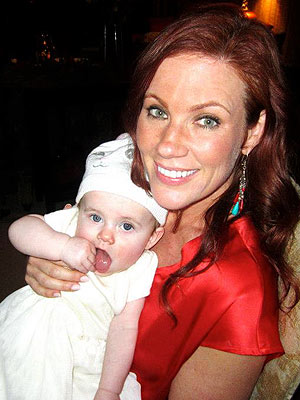
With Scarlett on Christmas – Courtesy Elisa Donovan
Thanks for welcoming one of our newest celebrity bloggers, Elisa Donovan!
Best known for her roles as Amber in Clueless and Morgan on Sabrina, the Teenage Witch, Donovan currently stars in the ABC Family franchise The Dog Who Saved Christmas. Following that, she will costar in MoniKa, set for release this year.
Donovan, 41, is also a writer and yogi. A recovered anorexic, she assists in counseling and supporting young women struggling with eating disorders.
She lives in San Francisco with her husband, Charlie Bigelow, and their 8-month-old daughter Scarlett Avery.
She can be found on Facebook, as well as Twitter @RedDonovan.
Okay — I want to talk about my body. Don’t worry, this isn’t going to get weird.
I hate to state the obvious, but women’s bodies — especially after they’ve had a baby — still seem to be an obsession of society. It’s a challenge to find a women’s magazine that doesn’t have at least one item about weight loss or body on its cover; or a women’s talk show that doesn’t have at least one feature on the same thing.
Since I had Scarlett, more people have wanted to talk to me about my body than anything else, so I thought I should jump on the bandwagon. (If you’ve read my previous blog, you’ll know how I feel about a bandwagon…)
Having recovered from anorexia many years ago, I’ve made it a way of life not to talk about my body, or your body or anybody else’s body. I learned long ago that at their core, eating disorders and “body image” issues have very little to do with the physical body at all. They’re about control, perfection and the size of our feelings and desires — not the size of our hips. For years, any comments made to me about my body — positive or negative — were twisted into a soup of insanity that only made me feel more fat; further convincing me that my restricted and unhealthy ways were the path to perfection.
It took many years of therapy, determination and love to overcome my disorder. Through my persistence and care, I have come to be grateful for the challenges I once faced. For my recovery brought me not only to the spiritual basis from which I now lead my life, but also gave me great knowledge and insight into the true goals and desires I have for my future.
One of the more literal and quantifiable assets to my recovery is this: I never judge anyone (including myself) by the physical body one walks around in. I am far more concerned with what is going on inside rather than outside. Skinny or fat, tall or short, sculpted or curvy — the body is truly one of the last things I focus on.
When I was anorexic and bulimic, I had a field day listening to what other people ate — creating my own contorted diets and restrictions in comparison. Then I would berate myself when I would inevitably fail at sticking to any of them; a process which inevitably led me back down the dangerous dead-end road of starving.
This is why today, in general, I don’t think that talking about food and body is healthy. I believe putting the focus on feelings, desires and goals is far more useful. So whenever I’m asked what I eat I usually dodge the question, not wanting to give women more reasons to create obsessions with their bodies, food and exercise.
But not even when I was severely anorexic and people would whisper things like, “I just want to give her a sandwich” was my body such a template for commentary, as it has been since I got pregnant and had a baby. So I thought maybe this was the time to break my silence in discussing this directly. I hope that by sharing my personal experience it may help to demystify the process of being healthy and fit.
Of course, every woman’s body is different. Hence, my experience is unique to me. As yours is to you. But it’s my hope that anyone who might be struggling with this can find the places they identify with what I’m writing and be brought some comfort; maybe our dialogue about this will help propel a shift in the collective consciousness.

Collage I made for Scarlett while I was pregnant – Courtesy Elisa Donovan
This stuff is really tough to talk about. See how I’m talking in circles around the subject so far? I’m cagey because, well — everyone goes bananarama-looney-tunes about this issue. We are all hyper-sensitive. And the last thing I want is to contribute to any of the insanity. I’m actually trying to stop the insanity, and bring us back down to earth. So here goes…
Throughout my pregnancy and post, it has been revelatory to discover just how much the body is what everyone — both men and women alike — feel most compelled to focus on. I’m not suggesting that people are instinctively mean-spirited in doing this. In fact, I’m trying to point out that I don’t think most people even realize it.
When someone comments about a woman’s pregnant or post-baby body, they think it is perfectly acceptable to do so. As if simply because a woman is about to have a child, or just had one, that makes her an open target for public discussion and invasion of her privacy.
I once watched a man at a party dig himself an Olympic-sized hole as he compared the bodies of two expectant women standing next to him (one of which was his wife). “You’re SO much bigger,” he said to the other woman. “You must be due really soon.” A bit stunned, the woman replied, “No, not for another three months.” “No way, really? It’s just that you’re so much bigger than her,” he said, pointing to his wife (who was mortified). “Maybe it’s the color of your sweater that’s making you look huge,” he offered, totally unaware of the gigantic gaping pit he had created for himself.
One friend told me that when she was six months pregnant a woman said to her, “You are ENORMOUS!! You look like you’re having twins!!” (She wasn’t.) Another woman, a complete stranger, said to me when I was almost five months, “You must be having a girl — you’re carrying it sort of … everywhere,” as she gesticulated grotesquely around her entire frame.
I’m just asking — in what universe are these appropriate things to say to a person?
Comments from “You barely look pregnant!” to “Oh my God — you’re huge!” to “You barely gained an ounce!” and “She gained a ton!” lead to “How did you lose the baby weight?” “Are you worried about losing the baby weight?” “Don’t worry — you will lose the baby weight!!” — and they all pre-suppose that one’s physical body is the main concern.
I can say with 100 percent honesty: I never worried about my weight when I was pregnant. Not once. Even during those periods where I felt like a water mammal trapped on land laboriously straining to lumber down the sidewalk, I didn’t worry about it. This is not because I have a super-human sized ego and gargantuan self-esteem. It is because of two things:
1) Everything I’ve already stated about my lessons in body image, and 2) I never looked at the scale when the nurse weighed me at each doctor visit. I told her I didn’t want to know what I weighed, unless there was something abnormal or unhealthy about it. I understood it was necessary for the doctor to know my weight, but it was virtually useless for me to know the number. I hadn’t looked at the numbers on a scale in over 15 years, so why should I start now?
Though I was never one of those women that felt AMAZING while pregnant (I did not see unicorns and rainbows all day and feel “sexier than ever!”), I did feel extraordinarily lucky that for the most part (aside from that brutal first trimester), I felt okay. Though much of this could just be chalked up to the luck of the draw, I believe my choices were an equal contributor.

Charlie and Scarlett at SFMOMA – Elisa Donovan
I didn’t change the quality of what I ate (aside from several fierce cravings which I will get to later, I am an organic and non-processed foods person). I didn’t take “eating for two” to mean “overindulge in every sugary, fatty food I can get my hands on for 10 months.” I ate when I was hungry (which was often) and made sure I got the proper vitamins and minerals from the foods I ate. (Roasted chicken was a favorite, I could not get enough of it. And lemon water. I would have swallowed an entire lemon tree if I could have.)
I also practiced vinyasa yoga nearly every day, when I wasn’t working. Especially on the days when I didn’t feel like getting off of the couch — those were the times it actually felt the best. I even practiced the day before I gave birth. (I loved knowing that I was carrying a baby in my belly in yoga, as I moved through the age-old postures and chanted at the opening and close of class.) I walked a lot. These things cleared my head, energized my body and lifted my spirit. They made me feel like an active participant in nourishing this little being, rather than sitting back and letting something just happen TO me.
Just so you don’t think I’m some out-of-touch-granola-hippie — you should also know that during my second trimester, I developed an insatiable desire for chocolate bars. This trimester fortuitously coincided with Halloween. I would send text messages to my girlfriends with photos of mini-Milky Ways, with the title “FUN SIZE!.” (To be clear: I believed I was maximizing the fun by eating three or four of them.) I would text my husband while he was at the office, “Can you bring me home a Snickers? Don’t judge me.”
For anyone that knows me, it was hilarious and a great source of joy for them to see me delight in eating these things. My chocolate bar fetish was soon replaced by a wild rampage in pursuit of anything red velvet. This is a story that requires its own blog altogether — so I will just tell you this: I have tasted every red velvet cupcake in the greater San Francisco Bay and Los Angeles County areas, and was known to drive over the Golden Gate Bridge just to purchase mini-bundt cakes.
After I had Scarlett, people very quickly said they couldn’t believe I had just had a baby. “OHMYGOD I hate you!” some women would even say, as if I had committed some personal crime against them by physically recovering what they considered to be too quickly. I know these sorts of comments were meant to be compliments, and on one level they were very nice to hear. But this didn’t mean I didn’t feel like a cow.
The reality was, I HAD just had a baby. So regardless of what my body looked like, I still felt predominantly crazy and pudgy. Emotionally, I was no different than anyone else who just had a baby, but because my body seemed to come back quicker, people equated that with everything going back to normal. Back to pre-pregnancy.
Let me take a moment to rally on behalf of striking the term “back to pre-pregnancy” from the lexicon we are allowed to use with regard to — well, anything. Because guess what—nothing is the same as it was before. Nothing. So why do we even pretend it is, or strive to make it so? People have told me I look just like I did before having the baby, that “you can’t even tell!.” This is both very kind and very false.
For one thing, my hips will never be the same … simply never be the same! I also think that my face, my boobs, and my everything else are all forever altered. And I don’t mean to say it’s all change for the worse. I think women’s faces change in a really deep and lovely way once they’ve had a baby; there’s an openness and a brightness that, even amidst the exhaustion and insanity of those first couple of months, is beautiful. I wouldn’t take my pre-pregnancy face back for anything … even for the circumference of my pre-pregnancy hips.
Like most women, I didn’t have an expensive trainer barking at me and kicking my ass into squats at 5 a.m. to “lose that pregnancy weight.” I didn’t have a fancy chef cooking me tastily gourmet but calorically feather-light meals; nor did I have full time help to watch my kid so I could run to the gym and yoga and spinning in order to “get my body back.”
But also like most women, I did have the natural workout (which felt like what I imagine prepping for a marathon might feel like) of suddenly being responsible for the survival and well-being of this tiny human. Between that stunning revelation, the sleep deprivation, and the sheer adrenaline required to metabolize both, my body was operating at maximum capacity from the second Scarlett was born.
To me, it felt like the constant actions of carrying her, walking up and down stairs while lifting car seats and strollers around, burned more calories than an hour on the treadmill could ever hope to.

Upside-down reading – a good start – Elisa Donovan
I guess what I’m trying to get at here is this: are we so concerned with what we look like that even a woman who has just given birth is supposed to make her primary focus and primary source of pride be “getting her body back?”
I am not condoning using childbirth as an excuse to not take care of yourself, nor am I suggesting that we completely stop complimenting one another altogether. But I am talking about the danger of body obsession taking over the psyche and trickling out into everything we do, and I am asking if we can find additional ways to support and applaud each other, not just for our physical appearance.
How did we get so far away from what matters, that living up to some ill-conceived standard of physical perfection has become so important? I wonder about how I will instill my beliefs in Scarlett, when there is an epidemic of body obsession surrounding her everywhere she looks.
How will I make sure she understands that an emaciated waistline and injected lips are not what make for a fulfilling and inspired life? Charlie and I can infuse our values in her daily and teach her by our own example what we believe is right; but how do I make sure she knows that our values are better, if the majority of images and words around her defy them?
Rather than focusing on diets and losing dress sizes, wouldn’t our energies be better spent figuring out how to love one another more, and how to enjoy the wealth of opportunities that are afforded us in 2013? Can’t we do better at encouraging curiosity and inner strength? Couldn’t we focus just a little more on cultivating expression and gaining wisdom, rather than on how to lose 20 pounds in 20 minutes?
I’d like Scarlett to know that her mom isn’t a total loon, just because she is not in constant search of the perfect diet. I hope that Scarlett grows up asking me about books and art and achieving goals, and not whether her stomach is too fat for the dress she is wearing.
I realize this may be a tall order. And I know I can not and should not shelter my child from everything the world will reveal to her. But I can strive to make sure she knows what her mom believes: That her brain, her spirit and her heart are far more valuable than the size of her behind.
– Elisa Donovan
More from Elisa’s PEOPLE.com blog series:













